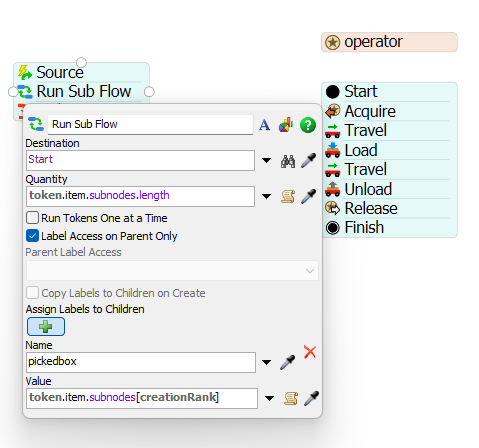i want to unload box one by one from pallet.
But there is problem in my simulation.
Please help me teachers.
i want to unload box one by one from pallet.
But there is problem in my simulation.
Please help me teachers.
The upper block in the Process Flow shouldn't be connected to the lower block. The source you placed there already creates a token for pallets that are unloaded to the queue. The token from the upper block has wrong references ("item" there refers to a pallet in the rack) and scrambles the logic.
You only assign the first box on the pallet to a label (pickedbox) and then only run the subflow once as well. To unload all items, run the subflow as many times as there are items on the pallet (subnodes.length) and assign the box references to each subflow-token individually. You should also implement some form of restriction, so that the operator only receives one task at a time. This can be done through a resource like with the forklift.
For the subflow you have two general options:
Create all tokens together
In this case, the box references have to iterate through the subnodes of the pallet (first token gets first box, second token gets second and so on...). When you assign labels to the subflow tokens in the "Run Sub Flow" activity, you have access to the creationRank value that denotes the "number" of the token. So "token.item.subnodes[creationRank]" will refer to a different box for each subflow token.
Since all tokens are created at the same time, the restriction to one task at a time should be placed inside the subflow.

Create tokens one by one
You can also set the activity to only have one token run through the subflow at a time. In this case, since the operator will have unloaded the item before the next one is created, the box reference can (and should since the number of subnodes decreases) just always point to the first subnode.
The Acquire and Release activity can be placed around the "Run Sub Flow" activity. Otherwise a second token from the source might interfere with an ongoing task since it will create its first subflow-token immediately and so the operator might start to unload a second pallet before finishing the first.

Lastly, items have to enter a conveyor through an Entry Transfer for the conveyor to work and move them along. It is created by creating a port connection from an (newly added) object to the conveyor. Afterwards you can delete the connected object. The transfer will persist and can be used to unload items into it.

I really appreciate your answer. Thank you.
Acutually I cant understand your answer 100%. Because I dont have basic concept.
I am learing flexsim using youtube, But there is a limit.
Can you recommand youtube channel or other way to learn?
Once again, Thank you so much your answer.
The core training is available as videos on FlexSim's Youtube channel (part 1).
There are also multiple tutorials as part of the online manual/documentation.
From there I would also recommend that you look at the overview about writing logic in FlexSim and basic functions. These contain information about how to access subnodes, as used in the example model, for example.
13 People are following this question.
FlexSim can help you understand and improve any system or process. Transform your existing data into accurate predictions.
FlexSim is a fully 3D simulation software environment. FlexSim can be used to simulate any process in any industry.
FlexSim®, FlexSim Healthcare™, Problem Solved.®, the FlexSim logo, the FlexSim X-mark, and the FlexSim Healthcare logo with stylized Caduceus mark are trademarks of FlexSim Software Products, Inc. All rights reserved.
Privacy | Do not sell or share my personal information | Cookie preferences | Report noncompliance | Terms of use | Legal | © Autodesk Inc. All rights reserved